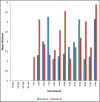Comparison of Dexmedetomidine and Magnesium Sulfate as Adjuvants with Ropivacaine for Spinal Anesthesia in Infraumbilical Surgeries and Postoperative Analgesia
- PMID: 28298786
- PMCID: PMC5341654
- DOI: 10.4103/0259-1162.200237
Comparison of Dexmedetomidine and Magnesium Sulfate as Adjuvants with Ropivacaine for Spinal Anesthesia in Infraumbilical Surgeries and Postoperative Analgesia
Abstract
Introduction: Postoperative pain is a major cause of fear and anxiety in hospitalized patients and so if patients remain pain-free during this period, they can cooperate with the circumstances well, leading to early recovery. Over the last two decades, there has been considerable revival of interest in the use of regional anesthesia techniques for surgery and pain management. As very few studies have been conducted using ropivacaine with dexmedetomidine and magnesium sulfate (MgSO4) as adjuvants, the present study was undertaken with primary aims to compare the hemodynamic stability, onset and duration of sensory and motor block and with secondary aims of the postoperative analgesic effect of dexmedetomidine and MgSO4 along with ropivacaine.
Materials and methods: After getting the Institutional Ethics Committee approval, this study was conducted on fifty patients of the American Society of Anesthesiologists physical Status I and II aged between 20 and 65 years of either sex and scheduled to undergo infraumbilical surgeries under spinal anesthesia. They were divided into two groups of 25 each. Group D patients received 3 ml of 0.75% isobaric ropivacaine hydrochloride with 10 μg of dexmedetomidine whereas Group M patients received 75 mg of MgSO4 in the place of dexmedetomidine. The quality of surgical analgesia and quality of intraoperative muscle relaxation were assessed and graded.
Results: We found out that onset of sensory and motor block was earlier in Group D in comparison to Group M. There was a significant reduction in the time to the first rescue analgesia in group receiving intrathecal dexmedetomidine.
Conclusion: It is concluded from our study that ropivacaine plus dexmedetomidine group are better than ropivacaine plus MgSO4 in providing early onset of sensory and motor block as well as in providing postoperative analgesia.
Keywords: Dexmedetomidine; magnesium sulfate; ropivacaine; spinal anesthesia; visual analog scale.
Conflict of interest statement
There are no conflicts of interest.
Figures
Similar articles
-
Comparing Effects of Intrathecal Adjuvants Fentanyl and Dexmedetomidine with Hyperbaric Ropivacaine in Patients Undergoing Elective Infraumbilical Surgeries: A Prospective, Double-Blind, Clinical Study.Anesth Essays Res. 2019 Oct-Dec;13(4):654-662. doi: 10.4103/aer.AER_183_18. Epub 2019 Dec 16. Anesth Essays Res. 2019. PMID: 32009711 Free PMC article.
-
A double-blinded randomized control trial to compare the duration of analgesia using morphine, clonidine, or dexmedetomidine as adjuvants to ropivacaine in caudal anesthesia in children undergoing infraumbilical surgeries.J Anaesthesiol Clin Pharmacol. 2024 Jul-Sep;40(3):388-394. doi: 10.4103/joacp.joacp_12_23. Epub 2023 Jul 7. J Anaesthesiol Clin Pharmacol. 2024. PMID: 39391669 Free PMC article.
-
Comparison of the Effects of Intravenous Fentanyl and Intravenous Dexmedetomidine on Characteristics of Spinal Anesthesia.Cureus. 2024 Oct 24;16(10):e72263. doi: 10.7759/cureus.72263. eCollection 2024 Oct. Cureus. 2024. PMID: 39583493 Free PMC article.
-
Dexmedetomidine and Magnesium Sulfate as Adjuvant to 0.5% Ropivacaine in Supraclavicular Brachial Plexus Block: A Comparative Evaluation.Anesth Essays Res. 2020 Oct-Dec;14(4):572-577. doi: 10.4103/aer.AER_28_21. Epub 2021 May 27. Anesth Essays Res. 2020. PMID: 34349322 Free PMC article.
-
Role of Dexmedetomidine and Clonidine With Hyperbaric Ropivacaine in Subarachnoid Block: A Comprehensive Review.Cureus. 2024 Jul 30;16(7):e65798. doi: 10.7759/cureus.65798. eCollection 2024 Jul. Cureus. 2024. PMID: 39219892 Free PMC article. Review.
Cited by
-
Comparing Effects of Intrathecal Adjuvants Fentanyl and Dexmedetomidine with Hyperbaric Ropivacaine in Patients Undergoing Elective Infraumbilical Surgeries: A Prospective, Double-Blind, Clinical Study.Anesth Essays Res. 2019 Oct-Dec;13(4):654-662. doi: 10.4103/aer.AER_183_18. Epub 2019 Dec 16. Anesth Essays Res. 2019. PMID: 32009711 Free PMC article.
-
Efficacy of dexmedetomidine with hyperbaric bupivacaine for postoperative analgesia in appendectomy: A randomized controlled trial.Medicine (Baltimore). 2025 Jul 11;104(28):e43368. doi: 10.1097/MD.0000000000043368. Medicine (Baltimore). 2025. PMID: 40660558 Free PMC article. Clinical Trial.
-
Effect of dexmedetomidine added to ropivicaine for caudal anesthesia in patients undergoing hemorrhoidectomy: A prospective randomized controlled trial.Medicine (Baltimore). 2018 Aug;97(34):e11731. doi: 10.1097/MD.0000000000011731. Medicine (Baltimore). 2018. PMID: 30142760 Free PMC article. Clinical Trial.
-
Dexmedetomidine versus magnesium sulfate as an adjuvant to local anesthetics in spinal anesthesia: a meta-analysis of randomized controlled trials.J Int Med Res. 2020 Aug;48(8):300060520946171. doi: 10.1177/0300060520946171. J Int Med Res. 2020. PMID: 32776799 Free PMC article.
-
Postoperative pain management in the postanesthesia care unit: an update.J Pain Res. 2017 Nov 16;10:2687-2698. doi: 10.2147/JPR.S142889. eCollection 2017. J Pain Res. 2017. PMID: 29180895 Free PMC article. Review.
References
-
- Kehlet H. Postoperative pain relief – What is the issue? Br J Anaesth. 1994;72:375–8. - PubMed
-
- Rawal N. Analgesia for day-case surgery. Br J Anaesth. 2001;87:73–87. - PubMed
-
- Cohen FL. Postsurgical pain relief: Patients’ status and nurses’ medication choices. Pain. 1980;9:265–74. - PubMed
-
- Brown DL, Carpenter RL, Thompson GE. Comparison of 0.5% ropivacaine and 0.5% bupivacaine for epidural anesthesia in patients undergoing lower-extremity surgery. Anesthesiology. 1990;72:633–6. - PubMed
-
- Wille M. Intrathecal use of ropivacaine: A review. Acta Anaesthesiol Belg. 2004;55:251–9. - PubMed
LinkOut - more resources
Full Text Sources
Other Literature Sources
Research Materials



